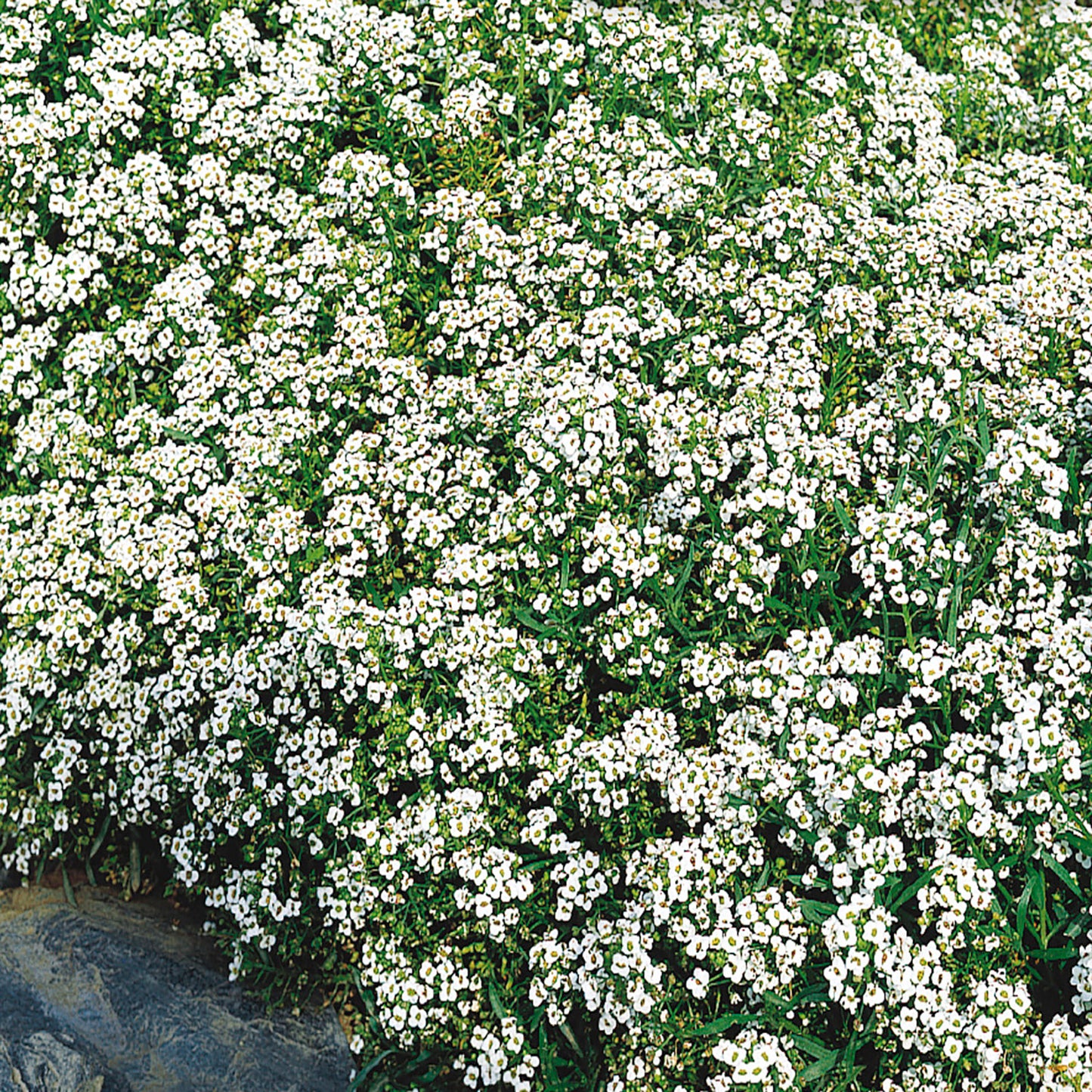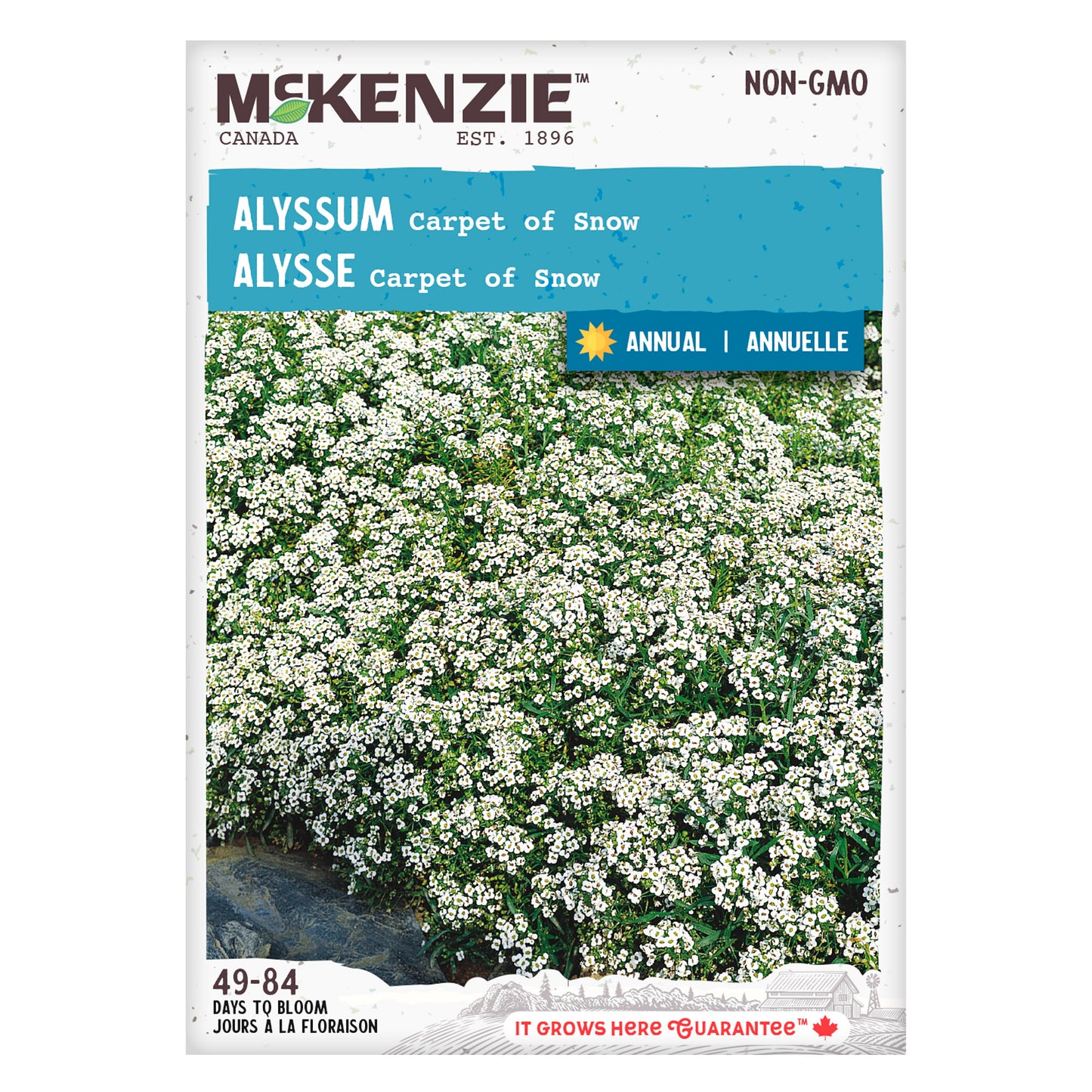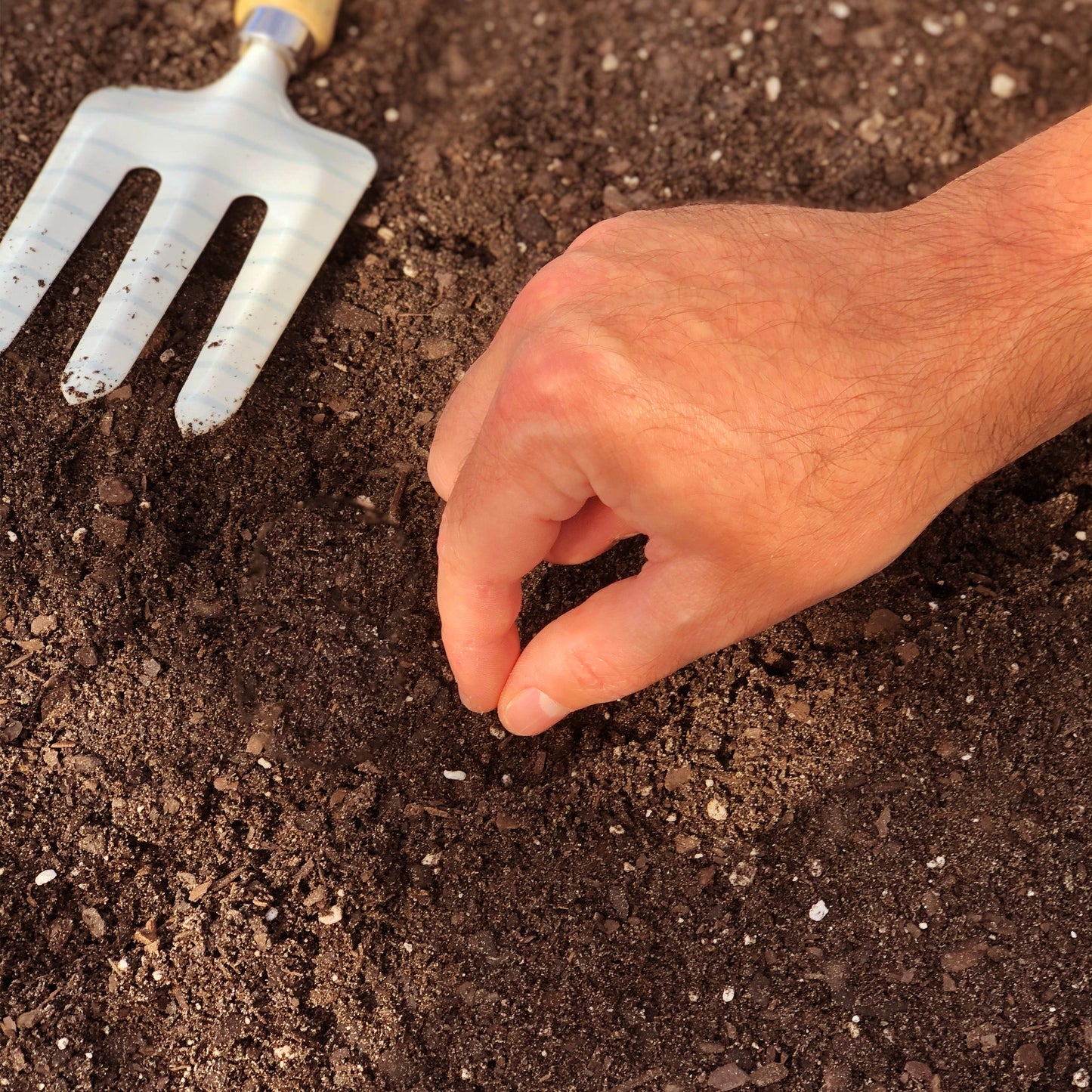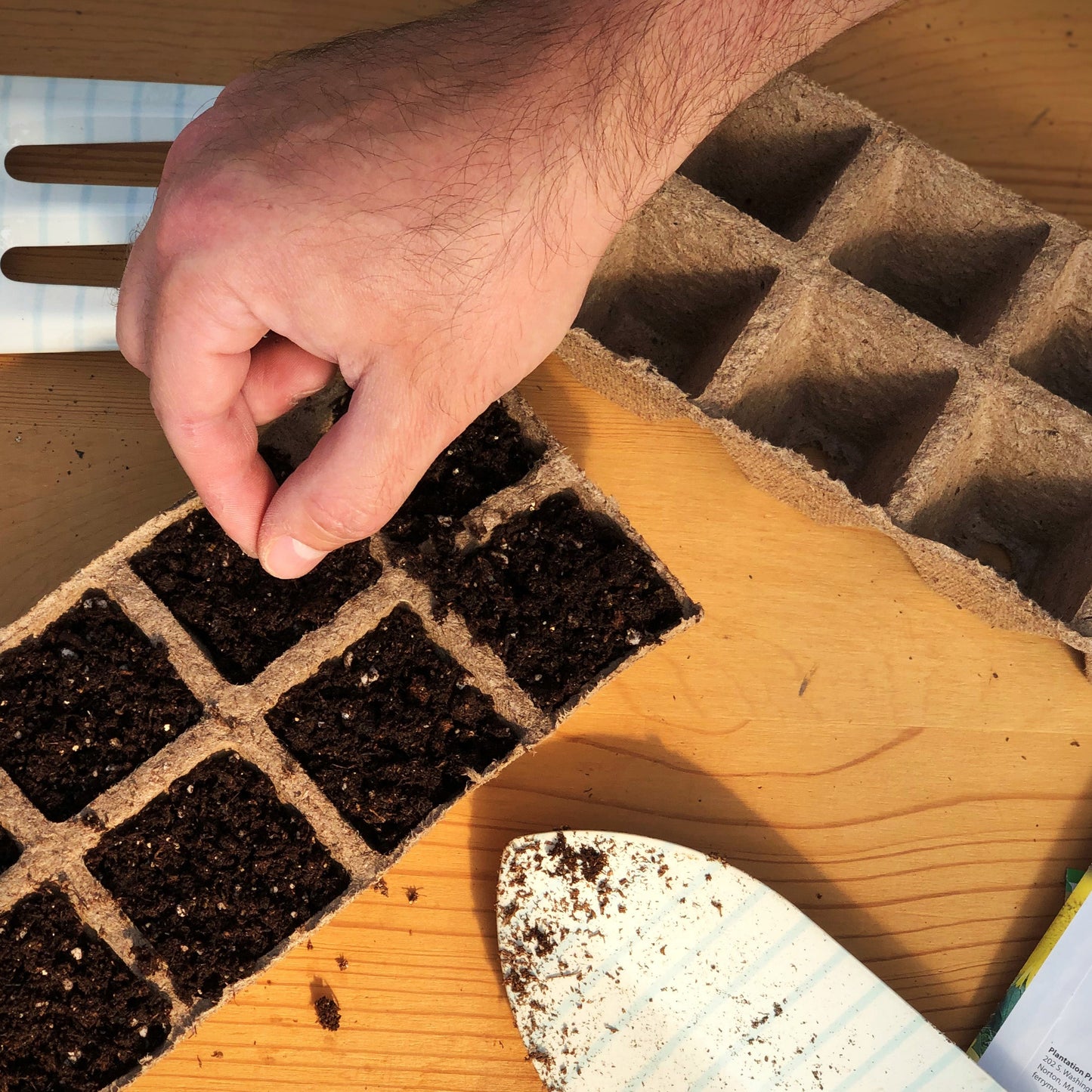35% off Seeds Use Code EARTHDAY. View All Current Offers. >
Earth Day Sale
1
/
of
5
Alyssum Seeds, Carpet of Snow
Lobularia maritima
Regular price
$1.89
Regular price
Sale price
$1.89
Unit price
/
per
Earn 2 points for this item with our
rewards program.
rewards program.

Product Information
Tiny pure white blossoms blanket the ground like new-fallen snow. Dwarf plants are uniform and compact, spreading rapidly. A fragrant choice for well-drained soils in rock gardens and borders. One of the finest cool weather performers. Blooms again and again if trimmed back to remove faded blossoms.
- SKU: 100008
Growing Information
Safe
for Bees
Grows
Best In:
Full Sun
Days to
Germination:
7 to 14 days
Water
Needs:
Average 2.5-5 cm (1-2") per week
Best
Container Size:
12"+
Growing Height:
8-10 cm (3-4")
Key Features
- Plant Type: Flower
- Botanical Name: Lobularia maritima
- Fill Weight (grams): 0.250
- Approximate Seed Count: 575-650
- Color: White
- Water Needs: Average 2.5-5 cm (1-2") per week
- Harvest/Bloom Season: June to Frost
- Scent: Honey
Instructions
-
Growing Instructions:
- Sow seed as soon as soil can be worked.
- Plants grow best in a light, loamy, well draining soil high in organic matter. The best way to ensure successful seed germination is to use well-cultivated, loose soil that is evenly moist. Before planting, it is recommended to incorporate a few inches of compost or well-rotted manure. This should be mixed into the top 20 -25 cm (8-10"). Plants grown in soil with lots of organic matter have healthier roots.
- Sow the seeds according to directions on the back of the seed packet and gently press them down, ensuring they have firm contact with the soil while still being exposed to light.
- Maintain adequate moisture in the soil until germination occurs; water whenever the soil feels dry.
- Sow seed indoors 6 weeks prior to last frost
- Use a McKenzie Seeds greenhouse or a good quality seed starting mix such as Jiffy. Follow the directions on the packaging for preparing and growing seedlings indoors.
- Do not cover Alyssum seeds with soil as they require light to germinate.
- A seedling heat mat is a tool that supplies a steady heat to the bottom of a plant or young seedling while it is being cultivated indoors. Its purpose is to facilitate the process of germination and encourage the development of roots by maintaining an ideal temperature for growth and sprouting.
- Prevent leggy plants by growing seedlings under an indoor grow light.
- Make it a habit to regularly monitor the moisture level of the soil on a daily basis to ensure that it remains adequately moist. It is crucial to prevent the soil from drying out or sitting in water as this can create unfavorable conditions that may result in damping off disease, a rapid fungal infection that can be fatal for young plants. To minimize the risk of damping off disease, it is recommended to water the containers from beneath so water is soaked up and ensure proper air circulation once the seedlings have emerged with the use of a fan.
- Prepare seedlings to be transplanted outdoors by hardening off. Before starting the hardening-off process, it is recommended to wait until the outdoor temperatures reach a minimum of 7°C (45°F). Hardening off is done by placing seedlings outside for an hour or two in the mid to late afternoon, ensuring they are shielded from direct wind and sunlight. Progressively increase the amount of time your seedlings spend outdoors. Each day, add an additional hour to their outdoor time, gradually exposing them to more sunlight and wind. Continue this process until they are able to withstand an entire night outside. If there is a risk of frost, seedlings should be brought indoors or covered with a frost-proof cover. Throughout the hardening-off period, it is crucial to keep the soil consistently moist.
- Once seedlings have been hardened off, they are ready to transplant outdoors.
- Prepare your garden by loosening the soil and removing any rocks and weed roots. Incorporate compost into the soil to enhance its fertility.
- Select an cloudy day to avoid exposing your seedlings to intense sunlight, as it can cause stress.
- Assess the moisture levels of your garden soil. It should be adequately moist but not excessively wet.
- Dig a hole slightly larger than the root ball of the plant and gently loosen the roots before placing it in the hole. This will promote the growth of strong roots.
- Position the plant in the hole at a depth similar to its previous pot, ensuring that its roots are covered with soil. Firmly but gently pack down the soil. If you live in a particularly dry climate, consider applying mulch around the seedling to prevent moisture loss.
- Regularly monitor your plants and ensure that the soil remains moist while they establish themselves in their new environment.
- If planting seedlings into containers, use a good quality potting mix/soil. Do not use garden soil in containers as it is too dense providing poor drainage and aeration.
- Planting Depth: 3 mm (1/8")
- Seed Spacing: 1.3 cm (1/2")
- Plant Spread: 20 cm (8")
Alyssum seed can be sown directly into the garden once all danger of frost has passed. Or for earlier blooms, start seed indoors 6 weeks prior to last frost.
Sowing seed directly into the garden
Sowing seed indoors
Transplanting seedlings outdoors
Suggestions
Growing Suggestions:
- Alyssum has the tendency to experience a decrease in flowering activity amidst the scorching heat of summer. However, it quickly rejuvenates and resumes its blooming cycle once the temperatures begin to cool down.
- Regularly removing spent flowers from sweet alyssum will promote continuous blooming and encourage the growth of fresh buds. If you have a large cluster of plants, trimming them by around one-third is a simpler alternative to deadheading.
- During periods of wet weather, downy mildew can occur as a coating on the leaves that is whitish or white with a slight purple tinge. To prevent this, it is important to plant alyssum in soil that is well-drained and follow the recommended spacing guidelines. This will allow for adequate air circulation around the plants and help mitigate the risk of downy mildew occurrence.





You may also like

Join our rewards program today to start saving!

Free Shipping on orders over $50

There are a ton of ways to earn!








